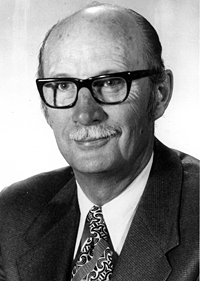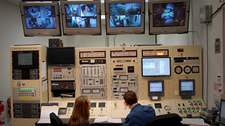Remembering an Atomic Age Pioneer
Dr. Raymond Murray, professor emeritus and pioneer of the atomic age, died Wednesday at Springmoor Retirement Community in Raleigh.
From the Manhattan Project to the Three Mile Island recovery, Murray took part in milestones of nuclear engineering and atomic power.

Murray was at NC State in 1950, the year the university introduced the nation’s first nuclear engineering curriculum and broke ground for America’s first university-based nuclear reactor. In 2000, he helped celebrate the physics department’s golden anniversary. For 18 years, he gave an annual lecture at MIT, speaking for the last time a few weeks ago.
The Manhattan Project
Murray was born in Lincoln, Neb., on Valentine’s Day, 1920. He grew up in nearby Havelock, working summers at a truck body factory and aircraft plant. When he entered college in 1936, he expected to become a high school teacher but became interested in physics, serving as an assistant with lecture demonstrations. He earned a bachelor’s degree in science from the University of Nebraska in 1940 and a master’s in physics the following year.
Shortly after graduation he married Ilah Mae Rengler and accepted a teaching assistantship in physics at the University of California at Berkeley. He had a year of graduate study, taking courses in electrodynamics and quantum mechanics from J. Robert Oppenheimer.
Murray’s studies were interrupted by World War II. He contributed to the national war effort on the famed Manhattan Project, which researched and built the first atomic bomb. Murray served in a research program to separate uranium isotopes using the electromagnetic method. In 1943 he was called to Oak Ridge, Tenn., to be the production supervisor in one of four buildings built to separate U-235 for the first atomic bomb. He remained at Oak Ridge after the war, leading service and research groups while continuing graduate study. He received a Ph.D. in physics from the University of Tennessee in 1950.
By that time the Murrays had three children, Stephen, Ilah Maureen, and Marshall.

University Frontiers
Murray joined a new nuclear engineering program at NC State as a physics professor in 1950. He contributed to the design, construction and operation of the first university reactor. As a faculty member, Murray faced post-World War II challenges, including resistance to an entirely new discipline, Cold War-era security that limited information about nuclear reactors and a lack of textbooks.
Murray wrote numerous journal articles and books, including Introduction to Nuclear Engineering, the first college textbook for the discipline, published in 1954, as well as Nuclear Reactor Physics in 1957 and Nuclear Energy in 1975. He authored Understanding Radioactive Waste and Physics: Concepts and Consequences, a college textbook for liberal-arts students.
He was named Burlington Professor of Physics in 1957, and headed the physics department from 1960 to 1963 and the nuclear engineering department from 1963 to 1974.
Dr. Murray received many honors, including the O. Max Gardner Award from the University of North Carolina system, the Arthur Holly Compton Award and the Eugene Wigner Reactor Physicist Award of the American Nuclear Society
After the death of Ilah Mae in 1966, Dr. Murray married Quin Davies Meyer, a social worker with the state. Her daughter Tucker became his stepdaughter. Quin died in 1977.
In 1979 Raymond married Elizabeth Davis Reid, writer of local history and former Raleigh council member. He acquired three stepchildren, Michael, Nancy, and Jim.
Three Mile Island and Beyond
After retiring teaching in 1980, Murray remained active in research and consulting, and as an advocate of the beneficial aspects of nuclear energy.
He was a member of the Bechtel Corporation team that carried out the recovery program for the damaged Three Mile Island nuclear reactor. His calculations helped ensure safe removal, storage and shipment of nuclear fuel.
Murray was a member of the Raleigh Sandwich Club starting in 1957, and a member of the Carolina Country Club, where he enjoyed playing golf for many years.
The Murrays traveled in Europe, Africa, and Asia and visited the Galapagos Islands. In 2005 they moved from their home, Murrayhill, to Springmoor Retirement Community, where they had many friends.
Survivors include his wife, Elizabeth; his children, Stephen of Arlington Heights, Ill., Ilah Maureen of Tulsa, Okla., and Marshall of Novi, Mich.; his stepchildren, Tucker Respess of Charlottesville, Va., Michael Reid of Atlanta, Ga., Nancy Reid Baker of Pfafftown, N.C., and Jim Reid of Raleigh; eight grandchildren, four step-grandchildren and 18 great-grandchildren.
The family requests that any donations be made to the Springmoor Endowment Fund or to a charity of the donor’s choice.
Dr. Raymond Murray, physics professor emeritus and pioneer of the atomic age, died Wednesday at Springmoor Retirement Community in Raleigh.
From the Manhattan Project to Three Mile Island recovery, Murray took part in milestones of nuclear engineering and atomic power.
Murray was at NC State in 1950, the year the university introduced the nation’s first nuclear engineering curriculum and broke ground for America’s first university-based nuclear reactor. In 2000, he helped celebrate the physics department’s golden anniversary. For 18 years, he gave an annual lecture for industry executives at MIT, speaking for the last time a few weeks ago.
Manhattan Project
Murray was born in Lincoln, Neb., on Valentine’s Day, 1920. He grew up in nearby Havelock, working summers at a truck body factory and aircraft plant. When he entered college in 1936, he expected to become a high school teacher but became interested in physics, serving as an assistant with lecture demonstrations. He earned a bachelor’s degree in science from the University of Nebraska in 1940 and a master’s in physics the following year.
Shortly after graduation he married Ilah Mae Rengler and accepted a teaching assistantship in physics at the University of California at Berkeley. He had a year of graduate study, taking courses in electrodynamics and quantum mechanics from J. Robert Oppenheimer.
Murray’s studies were interrupted by World War II. He contributed to the national war effort on the famed Manhattan Project, which researched and built the first atomic bomb. Murray served in a research program to separate uranium isotopes using the electromagnetic method. In 1943 he was called Oak Ridge, Tenn., to be the production supervisor in one of four buildings built to separate U-235 for the first atomic bomb. He remained at Oak Ridge after the war, leading service and research groups while continuing graduate study. He received a Ph.D. in physics from the University of Tennessee in 1950.
By that time the Murrays had three children, Stephen, Ilah Maureen, and Marshall.
University Frontiers
Murray joined a new nuclear engineering program at NC State as a physics professor in 1950. He contributed to the design, construction and operation of the first university reactor. As a faculty member, Murray faced post-World War II challenges, including resistance to an entirely new discipline, Cold War-era security that limited information about nuclear reactors and a lack of textbooks.
Murray wrote numerous journal articles and books, including Introduction to Nuclear Engineering, the first college textbook for the discipline, published in 1954, as well as Nuclear Reactor Physics in 1957 and Nuclear Energy in 1975. He authored Understanding Radioactive Waste and Physics: Concepts and Consequences, a college textbook for liberal-arts students.
He was named Burlington Professor of Physics in 1957, and headed the physics department from 1960 to 1963 and the nuclear engineering department from 1963 to 1974.
Dr. Murray received many honors, including the O. Max Gardner Award from the University of North Carolina system, the Arthur Holly Compton Award and the Eugene Wigner Reactor Physicist Award of the American Nuclear Society
After the death of Ilah Mae in 1966, Dr. Murray married Quin Davies Meyer, a social worker with the state. They traveled extensively, played golf, and collected antiques. Her daughter Tucker became his stepdaughter. Quin died in 1977.
In 1979 Raymond married Elizabeth Davis Reid, writer of local history and former Raleigh council member. He acquired three stepchildren, Michael, Nancy, and Jim. Elizabeth and Raymond traveled in Europe, Africa, and Asia and visited the Galapagos Islands.
Three Mile Island and Beyond
After retiring teaching in 1980, Murray remained active in research and consulting, and as an advocate of the beneficial aspects of nuclear energy.
He was a member of the Bechtel Corporation team that carried out the recovery program for the damaged Three Mile Island nuclear reactor. His calculations helped ensure safe removal, storage and shipment of nuclear fuel.
He is survived by his wife, Elizabeth; his children, Stephen of Arlington Heights, Ill., Ilah Maureen of Tulsa, Okla., and Marshall of Novi, Mich.; his stepchildren, Tucker Respess of Charlottesville, Va., Michael Reid of Atlanta, Ga., Nancy Reid Baker of Pfafftown, N.C., and Jim Reid of Raleigh; eight grandchildren, four step-grandchildren and 18 great-grandchildren.
The family requests that any donations be made to the Springmoor Endowment Fund or to a charity of the donor’s choice.
- Categories:


